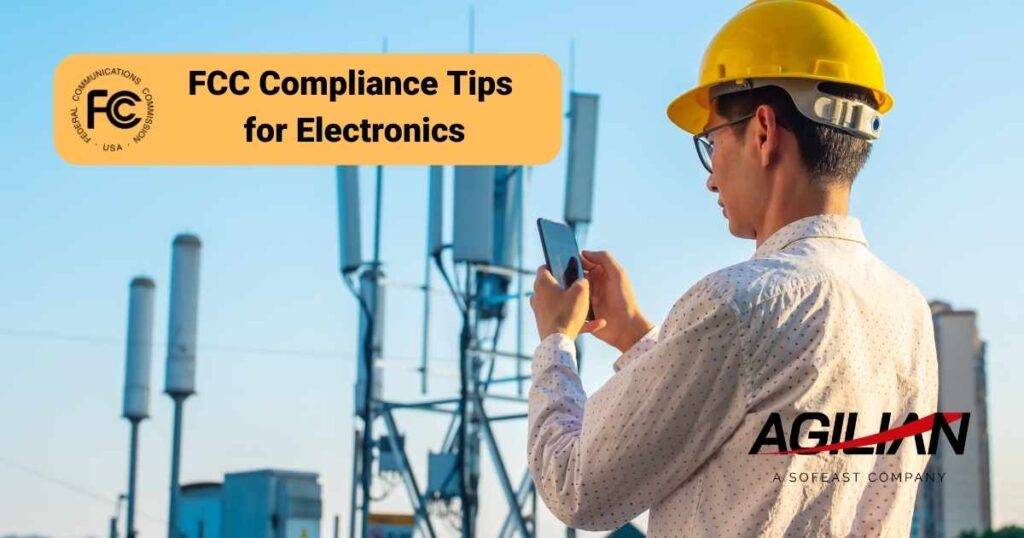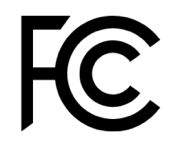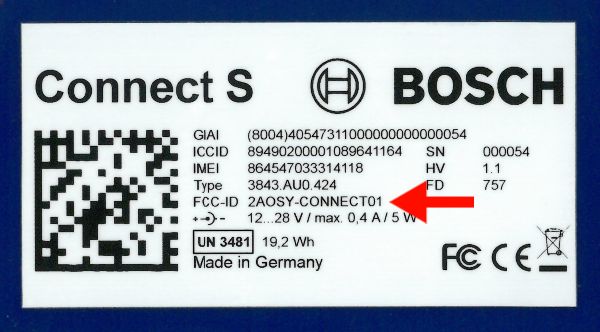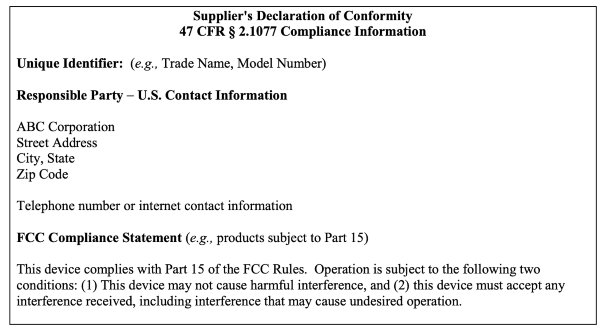
Agilian customers who are bringing new electronic products to market sometimes ask us to explain the FCC certification process so they understand if they must and how to get FCC certification for their products. So, I’ll cover that here, and there are some tips we can share on how to approach FCC compliance for your product so that you don’t run into any problems.
We’re going to focus on the steps you need to go through to prepare for your FCC authorization, however, before we do that, let’s just quickly go back over what the FCC is and the kinds of products that it applies to.
What is the FCC and do you need to comply with their requirements?
FCC is a U.S. regulation mainly for electronic products and it stands for ‘Federal Communication Commission’ operating under title 47 of CFR (code of federal regulations) part 15.

FCC is basically the police for checking what’s being transmitted and received over the U.S. airwaves and that really is about all kinds of electronics that in one way or another communicate over the airwaves and emit electromagnetic interference (EMI) and radio frequency (RF) emissions which could interfere with other devices. A key point for importers to remember as a rule of thumb is that if your product radiates at frequencies of less than nine kilohertz then you don’t need FCC compliance and approval.
So, one way to check if you really need to do FCC testing or not is to check the transmitting frequency range of the product. If it is less than nine kilohertz then you don’t need to do it and you just saved a lot of money! If it is higher than that, then you need to check if the product is listed in 47 CFR Part 15 as needing to be put through the FCC authorization process. If it is on the list, it will probably need to be tested and labelled before you can import it and sell it on the US market, and, in some cases, it will need to be directly FCC-certified.
The FCC mark is required in order to import and sell electronics in the USA that may cause RF and EMI interference.
What sort of products may require FCC compliance?
The following types of electronic products that either intentionally or unintentionally* emit radio frequency and/or electromagnetic interference may require testing, labelling, and FCC certification and their importation in the USA is controlled by 47 CFR part 15 (this is not an exhaustive list, rather it gives you an idea of product types requiring FCC compliance):
- Mobile and cordless phones
- USB-powered devices such as printers, power banks, and fans
- Bluetooth headphones, keyboards, speakers, smart watches, etc
- Telecommunication and radio broadcasting equipment
- LED lights
- RC car controllers
- Power adapters
- Wi-Fi internet routers
- Remote gate and garage door openers
- RFID scanners, such as card payment devices
*Broadly speaking, devices not used for telecommunication tend to be ‘unintentional radiators’ and those used in telecoms that must emit RF and EMI radiation as a part of their normal operation tend to be classed as ‘intentional radiators.’
The FCC classifies products into two categories:
- FCC Class A – products used in industrial environments and nonresidential areas
- FCC Class B – products for use in home environments
Consumer electronics, for example, are generally categorised in the stricter FCC Class B because these products will often be in an environment where they’re near to other devices and undue interference from them could cause negative effects on those around them.
Are any products exempt?
Electronics that don’t have any Wi-Fi or Bluetooth, like older digital cameras and some toys that have push-button functions like lights (not RC cars, though), probably come in under the nine-kilohertz range frequency and are exempt.
There are also a number of product types that are exempt from 47 CFR part 15 even though they may emit RF radiation, however, please check with your FCC testing lab regarding your particular product:
- A/C units
- Fan heaters
- Fridges
- Washing machines
- Cooking stoves
- Dishwashers
- Water heaters
- Carpet cleaning devices
Which FCC authorization is relevant to your product?
Let’s say you’re bringing a new electronic product to market that you think falls under 47 CFR part 15. What do you need to go through in order to prepare for that?
First, you need to understand what the FCC compliance requirements are and how they affect you. Depending on your product type, we’ll focus on these 3 authorization options:
- Verification
- SDoC (Supplier’s Declaration of Conformity)
- FCC certification
FCC Verification
The verification version of the FCC approval that usually goes by 47 CFR part 15 really applies to digital devices that either don’t have any radio, like a toy, or they do have a radio but it’s only radiating at a very low frequency of below nine kilohertz, as we mentioned earlier, and there are also other devices such as TVs, for example, that don’t really transmit and are just receiving which are also a good example of a product that just needs FCC verification.
The verification route is the simplest one for importers and is a self-testing process done by yourself or your manufacturer (if you trust them to carry it out) to ensure that it reaches the FCC’s requirements. The product will need to be lab-tested to assess whether it is emitting electromagnetic interference (EMI) and radio frequency (RF) above the FCC’s permitted levels (this is universal across each authorization approach). Once the verification is complete, the manufacturer can affix the FCC logo or label to the product and you should be good to go for selling it on the US market.
How much does FCC verification cost?
FCC verification could be cheap, in the order of maybe thousands of dollars or even hundreds depending on how small the device is, although you should always carefully check that your product is actually exempt from requiring FCC SDoC or FCC certification in order to reduce the risks of accidentally importing a non-compliant product that unwittingly falls foul of FCC compliance rules.
Supplier’s Declaration of Conformity (FCC SDoC)
Most unintentional radiators, which tend to be products that do not have a radio (therefore devices which have Wi-Fi and/or Bluetooth are not eligible for the SDoC) but do emit RF and EMI radiation, such as LED lights and portable batteries, will need to go through this particular FCC authorization procedure. This is a self-certification process that involves the product being tested to verify that the RF and EMI radiation levels emitted fall within FCC’s boundaries of 9kHz to 3,000 GHz, however, you do not need to use an official FCC-accredited laboratory for the testing, and you will not receive any official documentation from the FCC after testing is passed. Finally, an FCC SDoC-authorized product may feature the FCC logo on its labelling.
Once you have gone through the FCC SDoC process, this bundle of information will most likely be used to check the product’s FCC compliance by the FCC themselves, market surveillance authorities, border agents, your distributor, and/or your customers.
The FCC SDoC requirements includes:
- Product information – this is the product ID such as its name and model, SKU, or serial number which is repeated in the technical documentation, instruction manual, FCC test report, labels, and so on
- Responsible party – who they are, their address in the USA, contact details, and signature (this may be a company or an individual, and must be resident in the USA)
- FCC test report – this is provided by the laboratory used and the product ID should match that given so the report can be confirmed for the product in question
- Compliance statement – this is signed by the responsible party and confirms that the device is in compliance with 47 CFR part 15 regulations. The FCC provides this example here:

The compliance statement is to be included in the instruction manual/information for consumers to easily access.
How much does FCC SDoC cost?
An SDoC could cost at least several thousand dollars. Really anywhere from two to around ten thousand dollars depending on the product size, the number of components, and the number of tests required.
How you might be able to save some money by getting your intentional radiators through SDoC authorization instead of FCC certification…
In general, intentional radiators that have internal radios and must emit radiation in order to operate correctly, such as Wi-Fi and Bluetooth-enabled laptops or mobile phones, cannot go through the SDoC process. They will need to go through the full FCC certification process. However, there is a loophole that might help you to avoid the extra expense of FCC certification.
Sometimes some of the key components in these products, for example, the Wi-Fi chip in the laptop or Bluetooth chip in a Bluetooth mouse, already have FCC certification. Because those are the only components that are actually radiating and emitting the transmitting frequency, an SDoC may be able to be done for the product as a whole allowing you to save a lot of time and money on testing. You just need to make sure that the FCC ID of the Wi-Fi chip, for example, from your product that already has the FCC approval, is placed on your label. As a supporting document for the Declaration of Conformity, you may include the component’s test report from the FCC-accredited lab and FCC ID of the component as well as the rest of the documents and information mentioned earlier that belongs in the SDoC bundle.
This is a popular FCC compliance approach for a lot of importers of Wi-Fi and Bluetooth products with an off-the-shelf FCC-certified radio because it’s cheaper and less time-consuming than doing an FCC certification on the entire product. You will only need minimal tests to confirm the device’s frequencies, instead. Just be sure that when sourcing the components you get confirmation and documentation from the supplier that the component actually is FCC-certified. Of course, if your intentional radiator device includes cutting-edge components that have not yet been tested, you will have to undergo FCC certification and cannot do SDoC in this way.
FCC Certification
The last, and strictest, option is called FCC certification and that’s really for intentional radiator products that are more likely to cause interference with other signals and equipment (and products with a brand-new radio that has never been certified by the FCC before). An example would be cutting-edge smartphones, for example, a new iPhone, and there are so many people buying them that there’s no other option than to go through the FCC certification process. The same can be said for most new Wi-Fi or Bluetooth-enabled products.
Compliant products will include the FCC ID in their labeling, as you can see in this example belonging to a Bosch asset monitor (courtesy of this FCC report):

Unlike verification and the SDoC, you must use an FCC-accredited laboratory for the testing, and the FCC certification will be issued by an FCC-recognized TSB (Telecommunication Certification Body) such as Intertek, Eurofins MET Labs, TUV Sud America, SGS North America, and more (a searchable FCC database of TSBs can be found here).
The FCC certification process
If your product is in that category, then you need to follow the FCC certification process for the intentional transmitter parts of your product, such as a Bluetooth transmitter, whereas the remainder can be FCC-authorized using the SDoC route. Here’s the rough process you will follow:
- Register with the FCC and obtain your ‘FRN’ and ‘grantee code’ – before you start the testing and certification process for your product you will need to register an account with the FCC on its CORES page. You should apply for your 10-digit FCC Registration Number (FRN) which you need to undergo the certification from them. Obtaining the FRN is simple, it requires adding some information about yourself, your business, the product, and contact information. You can apply for the grantee code here, this is a 5-digit code that will identify your product as and when it is certified.
- Find a suitable FCC-accredited testing lab – testing laboratories that have been accredited by the FCC are widely available and you can search for them on the FCC website here. It will be wise to double-check that they are familiar with your product and its specifications and have the capabilities to do the required testing before you start working together.
- Submit the product for testing – the testing lab will need working product samples that are the same as will be mass-produced. They will tell you to give them two, five, etc, samples for this particular test. They assess however many they feel you need to provide and then they will give you a quote. The cost may rise depending on how complex the product is and how many chips you have in there that are causing the RF and EMI radiation.
The testing could take several weeks for larger, more complex products.
They’re going to ask you for all sorts of product information, including a product requirements document, user manual, electrical specification or electronic specification document that shows all the electrical sophistication for your product. In some cases, they will ask you for building materials as they may want to know the precise part number of the chip that is emitting that frequency, for example, so they can actually go online, search, and download its specifications. They will move through it and see what kind of testing methodology and so forth the FCC requires for that kind of component so it can get really tricky to gather all of this information, but it will be required by the lab and in the following step, too. - File the results and obtain the certification – after the product has passed its testing, you need to apply to the selected TCB with much of the same product, technical, and test information included in the SDoC, as well as a completed Form 731 for FCC certification applications (found here).
Once they have checked the information, they will provide you with FCC certification and upload the product details onto the FCC database. You will obtain the certification and FCC-ID which will be included in the product labeling.
There may be some fees to pay for the various documentation and codes from the FCC, these might vary, so please check the above FCC links for details relevant to your case.
One of the key benefits of obtaining the FCC-ID is that anyone can go to the FCC website and check whether this device has been certified by the FCC or not which is helpful for retailers, customers, and market surveillance authorities to verify FCC compliance.
How much does FCC certification cost?
Obtaining the FCC certification is complicated and it takes a long time. Sometimes it takes a month for testing complicated electronics and it can cost anywhere from around ten thousand to several tens of thousands of dollars, perhaps around fifty to sixty thousand depending on the complexity of the product.
If you feel that one lab is too expensive you can always go to another, and it really helps to get several different quotes because, depending on where you are, the costs vary. For example, in China, quotes from FCC-accredited labs are a little bit cheaper but then you have to haul your product samples all the way to the lab in China. If you’re not developing and manufacturing the product in China, that could be a problem. If you’re in Europe then you can go through European labs which have a reasonably good price, although they tend to be slightly more expensive than their Chinese counterparts.
Should you go into production during the testing process?
It’s advisable to only make a small run of the product, we’re talking fewer than 100 pieces, and then send some of those samples for compliance and reliability testing, then this way you get the find all of the bugs in your production process and if the product passes you’re in luck and can kick off the production.
Once you’ve got the lab starting to work on your product testing it’s wise just to wait until the testing is done. I would not recommend going into full production while your product is going through compliance tests because if anything is found that leads to you not obtaining the FCC verification, SDoC authorization, or certification, you’re in trouble because you can’t sell that product you just mass-produced thousands of pieces of on the US market.
Conclusion
As ever there’s a lot to know about product compliance and FCC compliance is not a small potato to figure out in a couple hours or so, so this was written to give you an introduction to the process and help you to understand what might be expected from your product.
We are here to answer questions for our clients who are in need of either reliability or compliance testing and/or manufacturing and we’re glad to help, so get in touch with us by hitting the button below:
Disclaimer…
We are not lawyers or an FCC-accredited expert. What we wrote above is based only on our understanding of the regulatory requirements for new products. Agilian Technology does not present this information as a basis for you to make decisions, and we do not accept any liability if you do so. Please consult a lawyer and/or get an FCC-accredited lab’s advice before taking action.




